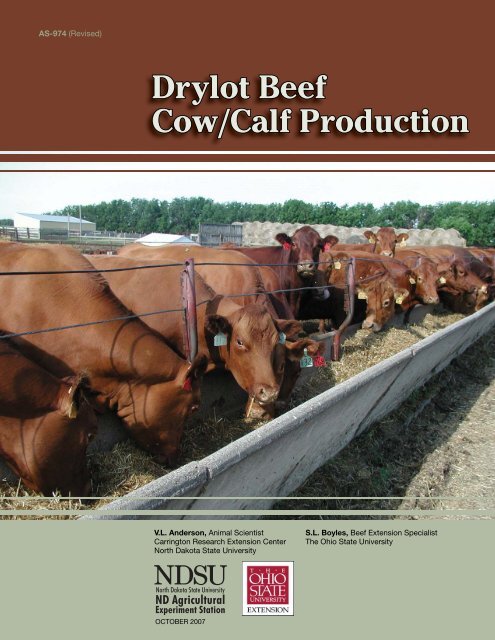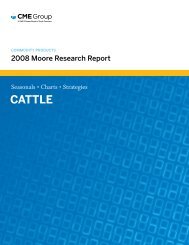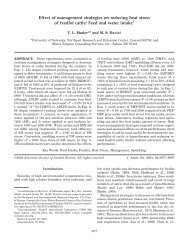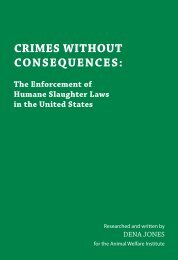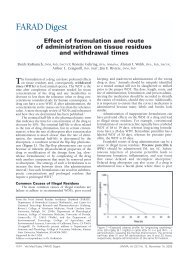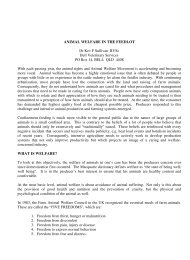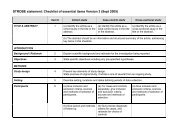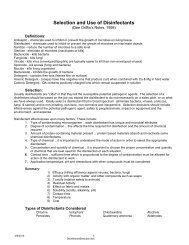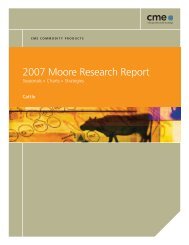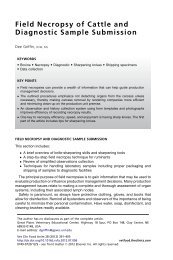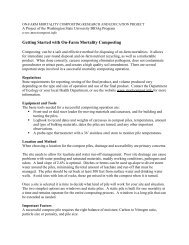Drylot Beef Cow/Calf Production AS-974 PDF
Drylot Beef Cow/Calf Production AS-974 PDF
Drylot Beef Cow/Calf Production AS-974 PDF
Create successful ePaper yourself
Turn your PDF publications into a flip-book with our unique Google optimized e-Paper software.
<strong>AS</strong>-<strong>974</strong> (Revised)<br />
<strong>Drylot</strong> <strong>Beef</strong><br />
<strong>Cow</strong>/<strong>Calf</strong> <strong>Production</strong><br />
V.L. Anderson, Animal Scientist S.L. Boyles, <strong>Beef</strong> Extension Specialist<br />
Carrington Research Extension Center The Ohio State University<br />
North Dakota State University<br />
OCTOBER 2007
2<br />
Why Consider <strong>Drylot</strong>?<br />
The drylot beef cow/calf enterprise is an alternative<br />
management system to traditional pasture or<br />
range beef production. Strictly defi ned, it is feeding<br />
confi ned cow/calf pairs in a feedlot environment<br />
during part or all of the traditional summer or fallwinter<br />
grazing season. In a practical sense, it means<br />
feeding confi ned cows and calves forages, crop<br />
residues and grains that may have more value<br />
marketed through cattle than as a cash crop. Many<br />
cattlemen manage their cows in drylot during the<br />
winter and after calving until pastures are ready.<br />
Advantages and disadvantages to consider include:<br />
Advantages<br />
• Increased marketability of crop residues, forages<br />
and other feedstuffs<br />
• More control of the herd for health and management<br />
• Easier synchronization and artifi cial insemination<br />
• Increased number of cows per bull with natural<br />
service<br />
• Flexibility of management (drylot during breeding<br />
or prior to weaning)<br />
• Very low weaning stress for calves<br />
• Easily integrated to backgrounding calves –<br />
“bunk broke”<br />
• More beef produced per acre due to effi cient<br />
machine harvest vs. grazing<br />
• Allows for pasture or rangeland restoration<br />
• Market for frost-damaged, drought-stressed,<br />
sprouted or cheap feeds<br />
• Extends production life of broken-mouth cows<br />
• Maximizes use of facilities<br />
• Increased manure accumulation for fertilizing<br />
cropland<br />
• Marketing fl exibility<br />
• Potential lower cost of production<br />
Disadvantages<br />
• Increased labor and equipment use for feeding<br />
• More manure spreading required<br />
• Faster depreciation of facilities and equipment<br />
• Higher level of management needed for ration<br />
balancing and herd health<br />
• Possible increased crowding and associated stress<br />
• Potential for more rapid spread of contagious<br />
diseases<br />
• More challenging environment (dust, mud, fl ies,<br />
etc.) for cattle<br />
• More harvested feed required for lactation and<br />
creep rations<br />
• Increased odor from manure<br />
<strong>Drylot</strong> will not replace grazing cattle to any great<br />
extent, but in some situations may supplement<br />
grazing practices or be a viable alternative<br />
management system. <strong>Drylot</strong> is an option during a<br />
drought, herd expansion or loss of pastures. <strong>Drylot</strong><br />
may allow new cattlemen the opportunity to start a<br />
herd without a large investment in land. Dairy farmers<br />
wanting to reduce labor output and still utilize feed<br />
storage and cattle facilities could switch to drylot beef<br />
cows. Farmers with weather-damaged, low-value or<br />
excess crop products, such as screenings, sprouted<br />
grains and straw or stover, may feed cows in drylot<br />
on a custom or profi t-share basis. Some crop<br />
rotations may benefi t from high-yielding forages that<br />
are harvested as silage or hay and marketed through<br />
drylot beef cows. Modeling studies suggest a typical<br />
eastern North Dakota farm of about 2,000 acres with<br />
conventional cropping could support 85 beef cows<br />
without deliberate feed production on the cropland<br />
acres. The addition of a drylot beef cow enterprise<br />
would increase and stabilize net income and improve<br />
the biological and economic sustainability of this<br />
farm.
Nutrition<br />
The critical period for drylot beef cows corresponds<br />
to the normal grazing season.<br />
Adequate nutrition must be provided for a cow to<br />
produce milk at her genetic potential plus return to<br />
estrus and rebreed for a 365-day calving interval. A<br />
wide variety of feedstuffs can be used in balancing<br />
cow rations. Ingredients should be analyzed for<br />
nutrient content and rations balanced to meet<br />
requirements based on milk production, cow<br />
condition, age and cow size. The National Research<br />
Council Nutrient Requirements of <strong>Beef</strong> Cattle (1996)<br />
provides basic nutritional information on dry matter<br />
(DM), energy, protein, minerals and vitamins for a<br />
range of cow weights of average and superior milking<br />
ability.<br />
Feeding by Nutrient<br />
Requirements<br />
<strong>Cow</strong>/calf pairs should be sorted and fed by nutrient<br />
requirements to avoid overfeeding or underfeeding.<br />
Young, thin cows and fi rst-calf heifers need more<br />
energy and protein in their diets and should be<br />
penned and fed separately to meet their needs.<br />
Mature cows in good fl esh need less energy per<br />
equivalent body weight. Dominant cows may prevent<br />
more timid animals from eating when feeder space<br />
is limited. The number of pens should allow for<br />
sorting and feeding cows in groups according to age,<br />
condition and stage of gestation/lactation. Different<br />
nutrient requirements based on milk production, cow<br />
condition and other factors may require additional<br />
pens for optimum use of feed resources. Breeding<br />
systems may impose additional pen requirements to<br />
expose cows to the desired breed of sire. After the<br />
breeding season is over, sorting cow/calf pairs by sex<br />
of calf will permit higher energy creep rations to be<br />
offered to steer or bull calves for faster growth and<br />
easier transition to the feedlot. Heifer calves should<br />
be offered a low to moderate energy creep diet to<br />
minimize fat deposition in the udder, which can affect<br />
milk production potential negatively.<br />
3
4<br />
Feedstuffs<br />
<strong>Cow</strong>s can utilize a wide variety of feedstuffs as<br />
long as the ration is palatable and balanced for the<br />
cow’s needs and genetic potential. Several years’<br />
experience with a drylot beef cow herd at the NDSU<br />
Carrington Research Extension Center has validated<br />
the concept that a balanced ration formulated to meet<br />
the cows’ needs supports healthy and productive<br />
animals with excellent reproductive performance.<br />
Corn grown for silage produces more energy per acre<br />
than any other crop. Corn silage is very palatable and<br />
conditions a ration with other ingredients. Alfalfa is<br />
excellent forage as haylage or dry hay and provides<br />
protein, energy and minerals. Nondairy-quality<br />
alfalfa or mixed grass-alfalfa forages should be fed<br />
at economic and nutritionally appropriate levels. A<br />
wide variety of feeds can be used for drylot cows.<br />
Consider cost per unit of protein and/or energy in<br />
purchasing and feeding these ingredients and include<br />
transportation and storage losses.<br />
Most all crop residues, Conservation Reserve<br />
Program hay, ditch hay, slough hay and other lowquality<br />
forages can be used in drylot diets when<br />
properly supplemented. The very poor-quality/<br />
indigestible forages should be used judiciously as<br />
impaction of the rumen can occur, especially with<br />
chopped low-quality forages at higher proportions of<br />
a dry diet.<br />
Ration 1 below has been used successfully for cows<br />
of average milking ability at the NDSU Carrington<br />
Research Extension Center Livestock Unit. Ration<br />
2 resulted in a few more open cows than Ration 1,<br />
but cow and calf growth were satisfactory. Ration<br />
3 is a no-silage diet for average milking cows. If<br />
100 percent hay rations are considered, analysis<br />
for protein and energy are critical. Grain and other<br />
supplemental energy or protein can be fed to make<br />
up any shortage. Distillers grains with solubles are<br />
commonly considered in cow rations. Rations 5 and<br />
6 provide example diets with ethanol coproducts.<br />
Condensed distillers solubles, a liquid coproduct, are<br />
useful when mixed with low-quality forage and is an<br />
excellent ration conditioner.<br />
Mineral requirements will vary with feeds. As a<br />
general recommendation, cows should be provided<br />
with trace mineral salt and a calcium (Ca)-phosphorus<br />
(P) mineral supplement to achieve a Ca-P ratio of<br />
1.5-to-1 in the entire diet. Use of distillers coproducts<br />
or grains may eliminate the need for a phosphorus<br />
supplement. A mineral mix can be fed free choice,<br />
but mixing it in the ration ensures more uniform<br />
intake. <strong>Cow</strong>s fed high volumes of crop residue<br />
may require more careful mineral supplementation.<br />
Special consideration needs to be given to mineral<br />
supplementation if defi ciencies or toxicity problems<br />
are known.<br />
Table 1. Rations for Lactating <strong>Beef</strong> <strong>Cow</strong>s in <strong>Drylot</strong> (Percent As Fed)<br />
Ingredient Ration 1 Ration 2 Ration 3 Ration 4 Ration 5 Ration 6<br />
Corn silage (35% DM) 70 78 - - - -<br />
Alfalfa-grass hay (15% CP) 30 - 80 18 - -<br />
Sunfl ower meal (39% CP) - 12 - - - -<br />
Grass hay (11% CP) - - - - 40 -<br />
Straw or stover - 10 20 32 23 36<br />
Wheat midds - - - 50 - -<br />
Dry distillers grains w/solubles - - - - 37 a -<br />
Wet distillers grains w/solubles - - - - - 64 a<br />
a These diet formulations should be considered examples of upper limits of distillers grains with solubles and also<br />
assume relatively lower levels of fat and sulfur in the coproduct used.
With the increased use of distiller grains with solubles<br />
in beef cow rations, fat and sulfur levels should be<br />
monitored closely. The maximum sulfur (S) level,<br />
according to the National Research Council (1996),<br />
is .4 percent. Excess dietary S can be a problem for<br />
ruminants for two reasons. First, high levels of sulfur<br />
(above 0.4 percent of diet dry matter) from feed and<br />
water can lead to polioencephalomalacia (PEM), or<br />
“brainers.” Second, sulfur interferes with copper<br />
absorption/metabolism. Producers in areas with<br />
suspected high sulfate in the water should test their<br />
water. In the table below, examples of distillers grains<br />
with solubles were created having a sulfur content<br />
of .60 percent, .80 percent and 1 percent and its<br />
impact on a corn-corn silage diet at different levels<br />
of inclusion. Notice the table has several situations<br />
where we are close or above the suggested maximum<br />
level of sulfur in the diet.<br />
Fat or oil content of cattle diets should not exceed<br />
5 percent to 6 percent of dry-matter intake. Dried<br />
distillers grains with solubles can range from 8<br />
percent to as high as 12 percent fat content, and<br />
other feeds contain some fat or oil as well.<br />
Table 2. Sulfer Content Scenarios for<br />
<strong>Beef</strong> <strong>Cow</strong> Diets<br />
Inclusion rate, Sulfur Content of Distillers Grains<br />
% DM .60% .80% 1%<br />
20 .21 .25 .29<br />
30 .27 .33 .37<br />
40 .33 .41 .49<br />
Limit Feeding or Partial<br />
Restriction of Hay<br />
Hay-restricted diets can be economical during winter<br />
feeding of gestation diets or summer lactation rations.<br />
Secure facilities to control hungry cattle are needed.<br />
For producers with marginal facilities, substituting<br />
grain for only part of the hay or roughage is advised.<br />
A minimum of 0.5 pound of hay per 100 pounds of<br />
body weight is suggested (6 pounds of hay/day for<br />
a 1,200-pound cow). During extremely cold weather<br />
or in pastures with little winter protection, hay could<br />
be increased to 0.75 pound of hay per 100 pounds<br />
of body weight or 9 pounds of hay/day for a 1,200pound<br />
cow). Additional forage can be provided in the<br />
form of low-quality hay, straw or stover bales placed<br />
in hay feeders. This hay, however, must be purchased<br />
or harvested at a low price to maintain an economical<br />
diet.<br />
Substituting grain for hay is economical when forages<br />
are in short supply or very expensive. In the past,<br />
grains often have been priced lower per unit of<br />
energy than hay but often higher per pound. In this<br />
scenario, smaller amounts of grain must be fed to<br />
substitute economically for hay. Feeding a restricted<br />
amount of grain with little or no forage can be a<br />
management problem as cows will compete for any<br />
available forage and “work the fences.” The following<br />
is an example study conducted at The Ohio State<br />
University (OSU) with 1,300-pound cows.<br />
1. Midgestation cows (November-December): Feed<br />
4 pounds of fi rst-cutting hay; 2 pounds of 36<br />
percent protein, vitamin, mineral supplement; and<br />
1 percent of cow body weight of corn per cow<br />
(e.g., 13 pounds for a 1,300-pound cow). For late<br />
gestation and or very cold weather, increase the<br />
corn an additional 2 to 3 pounds per head per day.<br />
2. Feed corn whole. Whole corn works better than<br />
ground corn when daily hay intake is limited to less<br />
than 5 pounds per day.<br />
3. Adjust corn intake to achieve desired weight and/<br />
or body condition score.<br />
4. When starting the program, take three to four<br />
days to increase the corn and decrease the hay a<br />
4-pound level. Make sure bunk space is adequate<br />
5
6<br />
so all cows get their share and that cows are<br />
in a securely fenced area.<br />
5. Table 3 is an example supplement (feed at 2<br />
pounds/cow/day).<br />
Ward et al. (2004) at South Dakota State University<br />
replaced alfalfa hay with increasing levels of dry-rolled<br />
barley to mid- and late-gestation cows from January<br />
to April. Control cows consumed 20 to 23.5 pounds<br />
of hay. The “low” barley treatment group consumed<br />
5.3 to 6.2 pounds of barley per day with 12.5 to 13.9<br />
pounds of hay. The “high” barley group ate 10.6 to<br />
12.6 pounds of barley plus 4.9 to 5.7 pounds of hay<br />
daily. A protein/trace mineral supplement was fed to<br />
all cows at 0.5 pound per head per day that provided<br />
200 milligrams of Rumensin per head. Both barley<br />
groups gained more weight and body condition<br />
than cows fed alfalfa with similar pregnancy rates<br />
observed during the following breeding season.<br />
Table 3. Supplement Formulation for<br />
High-grain <strong>Beef</strong> <strong>Cow</strong> Diet<br />
Ingredient Percent, DM Basis<br />
Ground corn 32.1<br />
Soybean meal 45.6<br />
Urea 4.1<br />
Limestone 7.8<br />
Dicalcium phosphate 4.3<br />
Trace mineral salt 3.2<br />
Dyna K (potassium) 2.3<br />
Selenium premix (200 ppm) .4<br />
Vitamin premix a .2<br />
Rumensin 80 b .12<br />
a Vitamin A, 15,000 IU/gram; Vitamin D, 1,500 IU/gram.<br />
b 192 mg Rumensin/hd/d.<br />
Supplement contains the following nutrients:<br />
Crude protein 36%<br />
Calcium 3.76%<br />
Phosphorus 1%<br />
NOTE: If using a commercial supplement, feed according to<br />
bag instructions.<br />
Alternative Feeds<br />
All potential feeds available in the region should be<br />
considered in drylot production. The conventional<br />
ones include corn, milo and sorghum silage; alfalfa<br />
hay and haylage; prairie hay; brome grass hay; millet<br />
hay; corn, milo and millet stover; cereal grain hay<br />
and straw; soybean meal; soybean hulls; canola and<br />
canola meal; sunfl owers and sunfl ower meal; fl ax;<br />
linseed meal; barley; barley malt; wheat; wheat mill<br />
run; corn gluten feed; distillers grains; condensed<br />
distillers solubles; fi eld peas; dry beans; oats;<br />
sorghum; and minor grains, such as rye and millet.<br />
Other feeds that are useful include potato processing<br />
products, beet pulp and tailings beet molasses and<br />
de-sugared molasses, screenings of all kinds, hulls of<br />
all kinds, food processing waste and several others. A<br />
number of studies at the NDSU Carrington Research<br />
Extension Center have focused on the usefulness<br />
of a wide variety of coproducts and new feed grains<br />
available in the region for the cow-calf and feedlot<br />
enterprises. The following briefl y describes some of<br />
the studies and results:<br />
Wet potato coproducts<br />
Lactating mature crossbred beef cows were fed<br />
high levels of wet potato coproduct (17 percent DM)<br />
which constituted 25 percent of dry-matter intake<br />
(DMI), wheat straw (45 percent of DMI), wheat midds<br />
(15 percent of DMI) and chopped alfalfa hay (15<br />
percent of DMI). Compared with corn silage-based<br />
diets, cows gained more weight and increased body<br />
condition score with the raw potato coproduct diet<br />
with no difference in conception rate.<br />
Barley malt or wheat midds<br />
Barley malt (25 percent of DMI) or wheat midds<br />
(22 percent of DMI) was included in lactating drylot<br />
mature beef cow diets with wet potato waste (54<br />
percent of DMI), straw (21 percent to 25 percent of<br />
DMI) and small amounts of alfalfa hay (12 percent of<br />
DMI) without negative effects. Conception rates were<br />
96 percent at fall pregnancy palpation. Wheat midds<br />
were fed at about 50 percent of DMI to lactating fi rstcalf<br />
heifers with straw at 32 percent of DMI and alfalfa<br />
at 18 percent of DMI with no observable difference,<br />
compared with the corn silage-alfalfa hay-based<br />
control ration.
Sunfl ower screenings<br />
In another treatment in this study, including sunfl ower<br />
screenings (37 percent of DMI replacing potato waste<br />
and malt/midds) resulted in signifi cant weight and<br />
body condition loss for the cows and decreased<br />
conception rate. This is a highly variable screenings<br />
product in which we observed decreasing nutrient<br />
content as the sunfl ower cleaning season advanced.<br />
Further work with sunfl ower screenings infected with<br />
sclerotinia bodies (52 percent of sunfl ower screenings<br />
on a weight basis) fed to mature lactating beef cows<br />
indicated no deleterious effect on gain or body<br />
condition score when this product was fed at about<br />
40 percent of DMI in a diet that contained corn silage,<br />
alfalfa hay and straw.<br />
Low-quality Barley<br />
Noninfected or infected (36 parts per million<br />
deoxynivalenol or DON) dry-rolled barley was fed<br />
to fi rst-calf heifers in mixed diets that included corn<br />
silage, alfalfa hay and straw. During mid and late<br />
gestation, heifers were fed 8.15 pounds of barley<br />
daily, with 9.37 pounds offered after calving. No<br />
negative effects were observed for cow and calf<br />
performance.<br />
Dry edible bean splits<br />
Dry bean splits must be roasted at 300 F if fed at<br />
more than 4 percent to 5 percent of DM intake to<br />
deactivate the enzyme mechanism that can cause<br />
severe diarrhea.<br />
Additional fi eld studies successfully have<br />
incorporated canola meal, linseed meal, sunfl ower<br />
meal, crambe meal, distillers grains, fl ax, oat hulls<br />
and other feeds in balanced mixed rations for<br />
lactating and gestating beef cows.<br />
The volume of coproducts continues to grow,<br />
especially with the development of the ethanol and<br />
biodiesel industries. Coproduct prices have had<br />
signifi cant seasonal swings, with lower demand<br />
and price in the summer. New and consistent<br />
export markets may challenge domestic supply<br />
and prices for some coproducts. The reader is<br />
cautioned to be careful in purchasing, for storage,<br />
coproducts with concerns about moisture content<br />
affecting shelf life and mold growth, fl owability and<br />
handling characteristics, variation and levels of fat<br />
and minerals, especially sulfur, and other physical<br />
and nutritional issues that may be problematic.<br />
Publications are available from NDSU (www.ag.ndsu.<br />
edu/pubs/beef.html) and OSU (http://beef.osu.<br />
edu) that provide additional information on various<br />
feedstuffs.<br />
Feed Preparation and Feeding<br />
Tub grinding hay or crop residues increases feed<br />
cost but reduces waste, enhances consumption<br />
and facilitates mixing with silages and concentrates<br />
or supplement. Some long-stemmed forage should<br />
be offered to stimulate rumination and prevent<br />
compaction. Generally, coproduct feeds do not need<br />
processing. Grains, however, should be rolled or<br />
ground to increase digestibility as the typical highforage<br />
cow ration has a high rate of passage through<br />
the gut and provides less resident time for larger<br />
grain particles to digest. Rations can be fed once per<br />
day, bunk space permitting. Twice daily feeding of<br />
drylot cows has not been evaluated. Some producers<br />
successfully have used self-feeding gates or electric<br />
fences to self-feed silage or hay; however, controlling<br />
consumption is diffi cult. Winter feeding on frozen<br />
ground with or without snow cover is acceptable<br />
if feed is placed on clean ground every day. This<br />
practice will facilitate distribution of manure during<br />
aftermath grazing.<br />
Creep Feed<br />
Calves in the drylot should be offered creep feed<br />
beginning at 2 months of age. Moderate energy<br />
rations should be offered to reduce overfattening,<br />
especially in heifer calves. Chopped mixed hay and<br />
feed grains (rolled or coarsely ground fi eld peas,<br />
barley, corn) or selected coproducts have been<br />
used successfully in mixed creep diets. Commercial<br />
pelleted diets are more convenient and cost more<br />
per ton. Malt barley pellets and wheat midds are<br />
useful as creep feed when mixed with corn, given<br />
7
8<br />
equivalent prices. Creep feed consumption increases<br />
to approximately 8 to 10 pounds per head per day at<br />
160 days of age. Creep pastures are recommended<br />
if grassed areas are available adjacent to the<br />
drylot. Using creep pastures reduces creep feed<br />
consumption, provides an improved environment<br />
and increases weaning weights in research at NDSU-<br />
Carrington.<br />
Early Weaning<br />
Early weaning is easier with drylot cows and can<br />
reduce cow feed costs while maintaining calf growth.<br />
Creep feeding is highly recommended prior to early<br />
weaning calves. Weaning drylot calves amounts to<br />
removing cows from the pen, with calves remaining<br />
in familiar facilities with water and creep feed<br />
available. Highly palatable, nutrient-dense mixed<br />
diets containing grains, coproducts, excellentquality<br />
forages and supplements, such as yeast, are<br />
recommended. Either fence line separation of the<br />
cows or total removal from the area can be practiced.<br />
After weaning anxiety is passed, cows can be turned<br />
out on small-grain stubble, nonfarmable lowlands<br />
and later corn residue. Early weaning allows cows to<br />
regain condition before winter, plus provides a longer<br />
time to graze crop aftermath.<br />
Herd Health<br />
Health problems experienced in the drylot are<br />
generally the same as those occurring in pasture/<br />
range operations. However, in a poorly designed<br />
and poorly managed operation, the drylot can<br />
be a hot, crowded, dusty or muddy, fl y-infested<br />
environment. A well-drained or paved site with a<br />
southern exposure and periodic manure removal<br />
reduces environmental stress. The high density of<br />
animals is conducive to spreading infections, so<br />
prompt, thorough treatment with appropriate followup<br />
is in order. Normal vaccinations and deworming<br />
are recommended. Consult your local veterinarian<br />
for specifi c recommendations. Foot rot can be a<br />
problem once established on the site, so prompt<br />
treatment is appropriate. Other problems that may be<br />
associated with drylot cows and calves are hairballs<br />
in calves and compaction in cows. These are very
infrequent occurrences, however. Hairballs can be<br />
mitigated by providing high-quality forage and creep<br />
feed separately to young calves to dilute ingested<br />
hair from shedding cows. Compaction is more likely<br />
to occur in cows fed large amounts of chopped straw<br />
without long hay or signifi cant amounts of silage or<br />
other moist feeds.<br />
Fly Control<br />
Regular manure removal, especially during rainy<br />
summers, is important in controlling the fl y<br />
population. Aggressive spraying of the premises<br />
with residual sprays, providing cows and calves with<br />
dust bags and rubs, and placing insecticide ear tags<br />
in the cows are all helpful. Wasps have been used<br />
successfully in isolated livestock operations. Feed<br />
additives that kill fl y larvae in the manure can be<br />
helpful if all animals in the area receive the product.<br />
No single practice should be relied on as the sole fl y<br />
control method.<br />
Breeding and Selection<br />
Estrus synchronization and artifi cial insemination are<br />
easier with cows in drylot. The concentration of cows<br />
in a small area allows faster and easier heat detection<br />
than in pastures or on the open range. Androgenized<br />
cows or sterilized bulls are useful for assisting in heat<br />
detection in the drylot. Natural-service sires used in<br />
the drylot can service 10 percent to 25 percent more<br />
cows due to repeated contacts and less distance to<br />
travel. Proven bulls with good libido should be used<br />
to take advantage of the increased exposure.<br />
A breeding plan should be developed using breeds<br />
that are acceptable to the producer and to the<br />
market. Systematic crossbreeding involving two<br />
or three breeds in rotation works well in drylot, but<br />
needs to be sustained with heifer selection and<br />
breeding back to the most unrelated breed of sire.<br />
Performance records are easier to keep in drylot with<br />
daily observation of individual animals. Selecting<br />
replacement females is easier and more accurate<br />
with good performance records. Weighing, tagging,<br />
vaccinating and treating animals are all much easier<br />
in drylot than on the open range.<br />
Herd Size<br />
An economical size for a drylot cow/calf operation<br />
has not been well-defi ned. Breeding systems with<br />
two or three breed rotations impose some minimum<br />
cow numbers on the enterprise. For example, a<br />
three-way rotation should have a minimum of 120 to<br />
150 cows to make the best use of herd sires while<br />
maximizing heterosis. Larger herds may be more<br />
effi cient due to economies of scale, but logistics and<br />
labor need to be addressed. Smaller herds of 50 to<br />
100 cows may be economically feasible, depending<br />
on the producer’s equipment, feed sources, facilities,<br />
labor and marketing goals.<br />
Marketing<br />
<strong>Drylot</strong> provides greater marketing fl exibility for both<br />
cows and calves. Prospective buyers can inspect<br />
feeder calves more easily. Reduced weaning stress<br />
and faster adaptation to feedlot rations are important<br />
merchandising points. Calves are more accessible,<br />
so market timing is fl exible. Cull or open cows can be<br />
fed longer if cheap feeds are available for improved<br />
return at slaughter or auction. Calves kept for feedlot<br />
fi nishing go on feed extremely well and may fi nish<br />
with higher marbling scores due to reduced stress<br />
and a longer feeding period. Red Angus-based steers<br />
at the Carrington Research Extension Center have<br />
been marketed at 1,225 pounds at less than 1 year<br />
of age and graded up to 75 percent USDA Choice<br />
or better. Having both spring and fall calving herds<br />
in one operation complicates management, but may<br />
provide more marketing windows and a consistent<br />
supply of beef if a fi nishing feedlot is included in<br />
the operation. Vertically integrated enterprises may<br />
market locally recognized, natural or organic meat<br />
through a local locker plant at premium prices.<br />
9
10<br />
Facilities and Equipment<br />
Site Selection<br />
The site chosen for a cow/calf drylot facility should<br />
be well-drained with appropriate pollution controls to<br />
avoid contaminating watersheds. Wintering quarters<br />
for gestating cows may need to be upgraded to<br />
control runoff. Check with state and county offi cials<br />
to determine permitting requirements. Site selection<br />
should be based on water availability, roads, slope<br />
of the land and soil type, proximity to neighbors,<br />
drainage, wind direction and odor. These are physical<br />
and operational criteria that can affect quality of<br />
life and relationships in the neighborhood. The<br />
reader is referred to the “Midwest Plan Service <strong>Beef</strong><br />
Housing and Equipment Handbook” (fourth edition,<br />
1987) available from your county Extension offi ce<br />
for facilities recommendations and critical design<br />
dimensions.<br />
Number of Pens<br />
Separate pens are suggested for (1) fi rst-calf<br />
heifers and old or thin cows, (2) the main cow herd<br />
with multiple pens if numbers require, (3) growing<br />
replacement heifer calves and (4) bulls, possibly two<br />
pens for young and old bulls. Large numbers of pairs<br />
in one pen make sorting for artifi cial insemination<br />
(AI) or health care diffi cult. Excessive crowding from<br />
severe weather, wild animals or other circumstances<br />
can result in injury or death to small calves. Sixty to<br />
80 pairs per pen is the recommended maximum, but<br />
this will vary with space allotment and pen design.<br />
Pen Design<br />
Pen size and lot space per cow/calf pair are quite<br />
variable, depending on the drainage and soil type.<br />
A general recommendation is for a minimum of 500<br />
square feet per pair, with 800 to 1,000 square feet<br />
desirable, especially with less than optimum drainage.<br />
Larger lots tend to allow more blowing dirt, a potential<br />
cause of pneumonia for baby calves. Partially paved<br />
areas may be useful around waterers and bunk lines,<br />
and for relatively fl at lots. Smaller paved areas (300 to<br />
500 square feet per pair) increase crowding but may<br />
reduce fl y problems and muddy cows, especially if<br />
paved areas are scraped often.<br />
Fencing<br />
Fencing for the drylot should be sturdy, lowmaintenance<br />
and able to withstand the stress of<br />
mature cows crowding and reaching. Used railroad<br />
ties, treated posts and steel pipe are long-lasting<br />
and low-maintenance. Steel cables or metal rod,<br />
such as well stem, sucker rod or pipe, are excellent<br />
for fencing. Mesh panels and lumber fences require<br />
more maintenance and will need replacement at<br />
much shorter intervals. Panels tend to get pushed<br />
out of shape in high-stress areas. Full-dimension<br />
rough lumber is preferred over smooth boards but<br />
often is warped and full of knots. High-tensile electric<br />
fence or barbed wire can be used successfully but<br />
requires frequent tightening. High-tensile fence is<br />
subject to penetration from crowding or frightened<br />
animals, requiring time-consuming sorting of animals.<br />
If animals put pressure on a fence, running an electric<br />
wire along the inside or the top of the fence may<br />
be necessary. Fences should be a minimum of 60<br />
inches tall, especially if larger cows or animals of<br />
questionable disposition are involved.<br />
Shade<br />
If shade is constructed, 40 square feet per cow/calf<br />
is recommended. <strong>Cow</strong>s made very limited use of<br />
the pole-framed corn-cribbing shade available at<br />
the Carrington Research Extension Center. Dualpurpose,<br />
shade/windbreak-designed, self-supporting<br />
structures may be useful equipment for beef cows in<br />
the northern Plains.<br />
Feed Bunks<br />
A variety of feed bunks works for cows. Mixed rations<br />
can be fed in fence line feed bunks or feeding fences<br />
designed without bunks. Feeding in bunks within<br />
pens is possible but mud and gate management<br />
can be problems. Feeders that can be placed inside<br />
pens include turned tractor tires, commercial metal or<br />
wood bunks, salvaged wide conveyor belting pulled<br />
up to a “u” shape or other containers. Round bale<br />
feeders or forage racks on a trailer chassis are useful
for feeding free-choice forages. Some feeders are<br />
more wasteful than others. Each cow should have<br />
26 to 30 inches of bunk space if rations are limit-fed.<br />
<strong>Cow</strong> rations are usually very bulky, so a high-capacity<br />
bunk is recommended. With fence line bunks, a<br />
concrete apron behind the bunk allows fi rm footing<br />
for the cows and easy cleaning. This apron should be<br />
10 feet to 12 feet wide and slope one-half inch per<br />
foot. Feeding on the ground is not recommended,<br />
even with large pens, as feed easily can become<br />
contaminated with feces and feed waste increases<br />
dramatically when feed is offered in this fashion.<br />
Water<br />
Water requirements of lactating cows in the summer<br />
are much greater than gestating animals. Lactating<br />
cows need up to 20 gallons of water per day. Tanks or<br />
water fountains may be adequate. The large reservoir<br />
of a tank allows more cows to drink in a shorter time,<br />
but cleaning large tanks can be diffi cult. Water should<br />
be accessible to young calves as well. A backup well<br />
or secondary water source is highly recommended.<br />
Creep Feeding<br />
Creep gates with adjustable vertical bars and<br />
openings 17 inches to 18 inches wide are most<br />
effective in providing access for calves but not cows.<br />
Creep feeders should be placed in well-drained areas<br />
easily accessible to calves, preferably along the<br />
opening to the creep pasture. Large-volume feeders<br />
have been designed for mixed grain-forage rations<br />
that can be fi lled with a feed wagon, front-end loader<br />
or large-diameter augers. Creep feeder space is not<br />
extremely critical. A minimum of 4 inches per head<br />
is suggested, with calves tending to eat in shifts,<br />
provided feed fl ows down adequately. Small fence<br />
line bunks may be used for calves but require more<br />
frequent fi lling.<br />
Feed Storage<br />
Feed storage should be close to the drylot. Bunker<br />
silos are cost-effective for large volumes of silage.<br />
Upright concrete stave silos and oxygen-limiting<br />
systems represent high capital investment items that<br />
could reduce labor but should be evaluated critically<br />
for positive economic returns in a beef cow/calf or<br />
feedlot enterprise. Returns from hay storage sheds<br />
depend heavily on a number of factors, including<br />
market price of hay and cattle, rainfall, bulk density<br />
of the hay package, original quality of the hay and<br />
length of storage. One- or two-year-old hay or straw<br />
is typically more digestible than new forage, although<br />
most Vitamin A is lost and some dry-matter loss<br />
occurs due to ground contact or weathering.<br />
11
Waste Management<br />
and Composting<br />
The economic value of manure from a confi ned cow<br />
operation depends on how it is handled and relative<br />
fertilizer prices. Incorporation of straw for bedding<br />
or from wasted feed improves the carbon-nitrogen<br />
ratio and sequesters much more nitrogen in the<br />
composted manure. Composting manure stabilizes<br />
and concentrates the nutrients, resulting in less<br />
total volume to be spread but more fertilizer value<br />
per unit. Composting can be done inside the pen or<br />
manure removed and “windrowed” for processing by<br />
a composting machine. Composting is a microbial<br />
process that converts organic wastes into stable,<br />
sanitary humuslike material that is an excellent<br />
fertilizer. Optimum moisture content for composting<br />
is 50 percent to 60 percent. A few weeks after piling,<br />
when the internal temperature has reached 130<br />
degrees to 140 degrees Fahrenheit, “rolling the pile<br />
over” with a composting turner or front-end loader<br />
and letting it start over is appropriate. The repeated<br />
turning assures more thorough composting of manure<br />
and bedding material and destroys weed seeds. The<br />
heating, or “thermophilic” phase, is repeated two<br />
to three times with normally a sequential reduction<br />
in temperature. This phase is followed by about<br />
two months of curing, or “mesophilic” phase, when<br />
turning should continue at less frequent intervals.<br />
Ideally, composted or fresh manure should be<br />
tilled into the soil just after spreading. <strong>Beef</strong> cows<br />
produce about 63 pounds of fresh manure per day.<br />
Accumulations from drylot cows on paved lots<br />
from May 1 through Sept. 15 average 1.75 tons to<br />
2 tons of dry matter, depending on cow size, ration<br />
digestibility and milk production of the cow. <strong>Beef</strong><br />
cattle manure from an open feedlot at 50 percent<br />
dry matter is estimated to contain approximately<br />
7 pounds of ammonium nitrate, 21 pounds of total<br />
nitrogen (N), 14 pounds of P 2 0 5 (phosphorus) and<br />
23 pounds of K 2 0 (soluble potash) per ton of raw<br />
manure. The value of organic matter and microminerals<br />
are harder to determine but can add<br />
measurably to the productively of the land. The<br />
manure should be analyzed for N, P (phosphorus) and<br />
K (potassium) and spreading be done according to<br />
permit and crop fertility recommendations.<br />
References and<br />
further reading<br />
Anderson, V.L. 2002. Sunfl ower screenings, barley malt or<br />
wheat midds in lactating beef cow diets. <strong>Beef</strong> <strong>Production</strong><br />
Field Day Proceedings. NDSU Carrington Research Extension<br />
Center. Volume 25:33-36.<br />
Anderson, Vern, and Blaine Schatz. 2002. Biological and<br />
economic synergies of integrating beef cows and fi eld crops.<br />
<strong>Beef</strong> <strong>Production</strong> Field Day Proceedings. NDSU Carrington<br />
Research Extension Center. Volume 25:38-41.<br />
Anderson, V.L., and E.J. Bock. 2000. Potato coproduct as<br />
a feed source for lactating mature beef cows and fi rst calf<br />
heifers. <strong>Beef</strong> <strong>Production</strong> Field Day Proceedings. NDSU<br />
Carrington Research Extension Center. Volume 23:12-13.<br />
Anderson, V.L., and E.J. Bock. 2000. Sclerotinia-infected<br />
sunfl owers as a feed source for pregnant and non-pregnant<br />
mature beef cows. <strong>Beef</strong> <strong>Production</strong> Field Day Proceedings.<br />
NDSU Carrington Research Extension Center. Volume 23:14-<br />
15.<br />
Anderson, V.L. 1998. Performance of primiparous lactating<br />
drylot beef cows on crop residue and processing coproducts.<br />
<strong>Beef</strong> <strong>Production</strong> Field Day Proceedings. NDSU Carrington<br />
Research Extension Center. Volume 21:1-4.<br />
Anderson, V.L., E.W. Boland and H.H. Casper. 1995. The<br />
effects of vomitoxin (DON) from scab-infested barley fed to<br />
gestating and lactating heifers. <strong>Beef</strong> <strong>Production</strong> Field Day<br />
Proceedings. NDSU Carrington Research Extension Center.<br />
Volume 18:11-12.<br />
Boyles, S.L., R.S. Sell and D.L. Watt. 1992. Adding an<br />
alternative livestock enterprise to a grain farm. J. Prod. Ag.<br />
5:422.<br />
Lardy, G.P., and V.L. Anderson. 2003. Alternative feeds for<br />
ruminants. NDSU Cooperative Extension Service. <strong>AS</strong>-1182. 23<br />
pages.<br />
Lardy, G.P., and V.L. Anderson. 2002. Canola and sunfl ower<br />
meal in beef cattle diets. Vet Clin Food Anim 18:327-338.<br />
Loerch, S.C. 1996. Limited-feeding corn as an alternative to<br />
hay for gestating beef cows. J. Anim. Sci. 74:1211-1216.<br />
MWPS-6 Midwest Plan Service <strong>Beef</strong> Housing and Equipment<br />
Handbook. 1987. Fourth edition.<br />
Sell R.S., D.L. Watt and S.L. Boyles. 1993. The economics of a<br />
low input drylot cow/calf operation integrated with a minimum<br />
till or conventional grain farm. Prof. Anim. Sci. 9:20.<br />
Ward, E H., H.H. Patterson and R.J. Pruitt. 2004. Response of<br />
gestating beef cows to limit-fed diets containing rolled barley.<br />
Proc. Western Sec. Amer. Soc. of Anim. Sci. P. 22-24.<br />
For more information on this and other topics, see: www.ag.ndsu.edu<br />
NDSU is an equal opportunity institution.<br />
This publication will be made available in alternative formats for people with disabilities upon request, (701) 231-7881.


